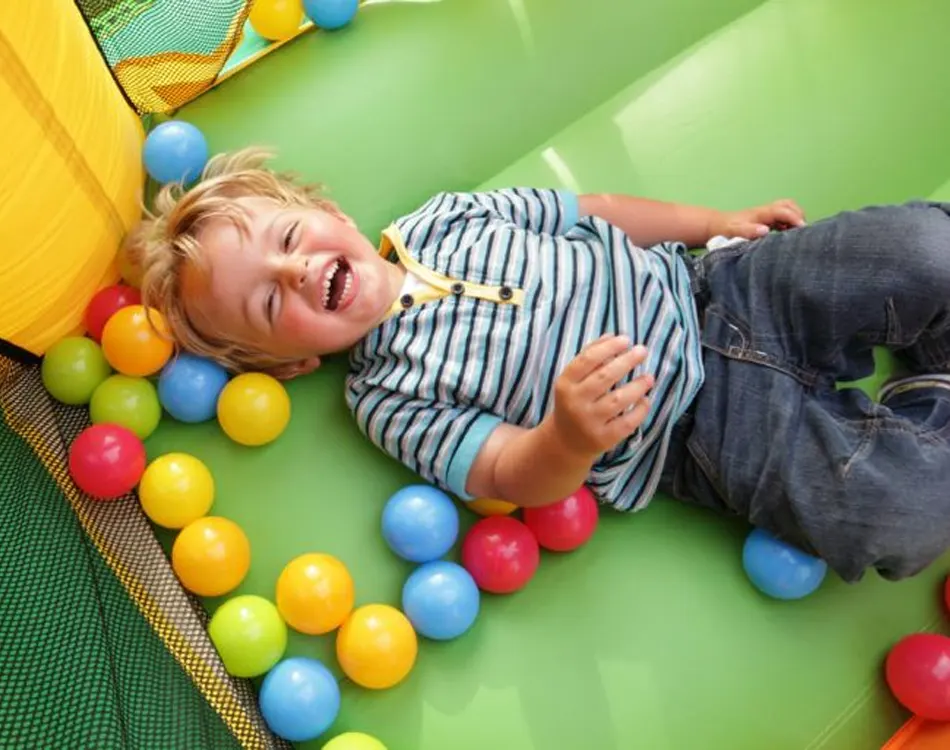
معدات اللعب الناعمة لمرحلة ما قبل المدرسة ودور الحضانة
تم تصميم حلول اللعب الناعمة لدينا لخلق بيئات آمنة وجذابة وتعليمية للمتعلمين الصغار. من خلال الجمع بين المواد المتينة والتصميم المدروس، تعزز منتجات اللعب الناعمة لدينا التطور البدني والإدراكي مع تشجيع اللعب النشط. مثالية لمرحلة ما قبل المدرسة ومراكز الرعاية النهارية ومناطق اللعب الداخلية، تتضمن مجموعتنا حصائر لعب ملونة وهياكل تسلق مخصصة وعناصر تفاعلية تعزز التنسيق والتوازن والتفاعل الاجتماعي. يمكن تخصيص كل قطعة لتناسب الاحتياجات الفريدة لمساحتك، مما يضمن بيئة تعليمية ممتعة وآمنة للأطفال من جميع الأعمار.
مجموعتنا المتنوعة من معدات اللعب الناعمة
تتضمن مجموعة منتجاتنا كل شيء من حصائر اللعب النابضة بالحياة إلى هياكل التسلق المخصصة، وكل منها مصمم مع وضع المتعة والوظائف في الاعتبار. اختر من بين مجموعة متنوعة من عناصر اللعب الناعمة والملونة والمتينة، بما في ذلك هياكل التسلق والمنزلقات والأنفاق والمزيد. تصفح مجموعتنا للعثور على معدات اللعب الناعمة المثالية لإنشاء منطقة لعب ديناميكية وآمنة للأطفال من جميع الأعمار.
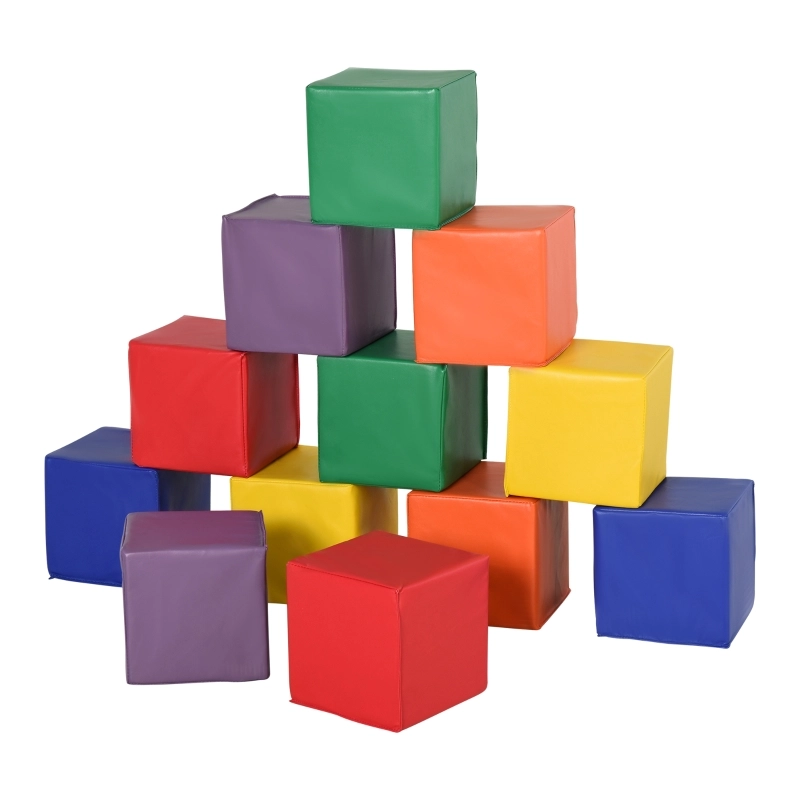
مكعبات لعب ناعمة مكونة من 12 قطعة
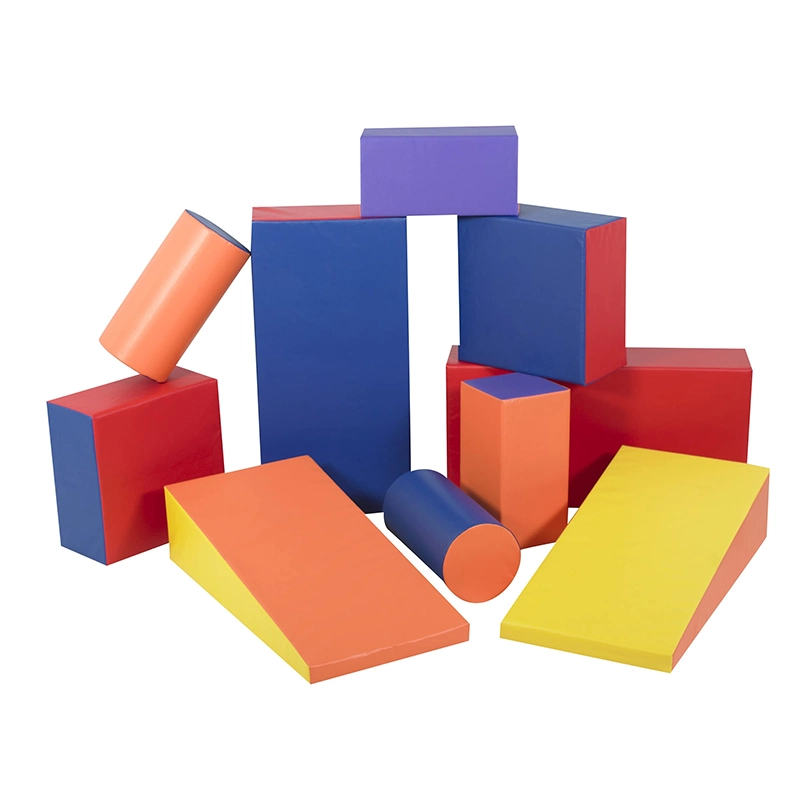
مجموعة الأشكال الناعمة من المصنع

ركن هادئ في الربع
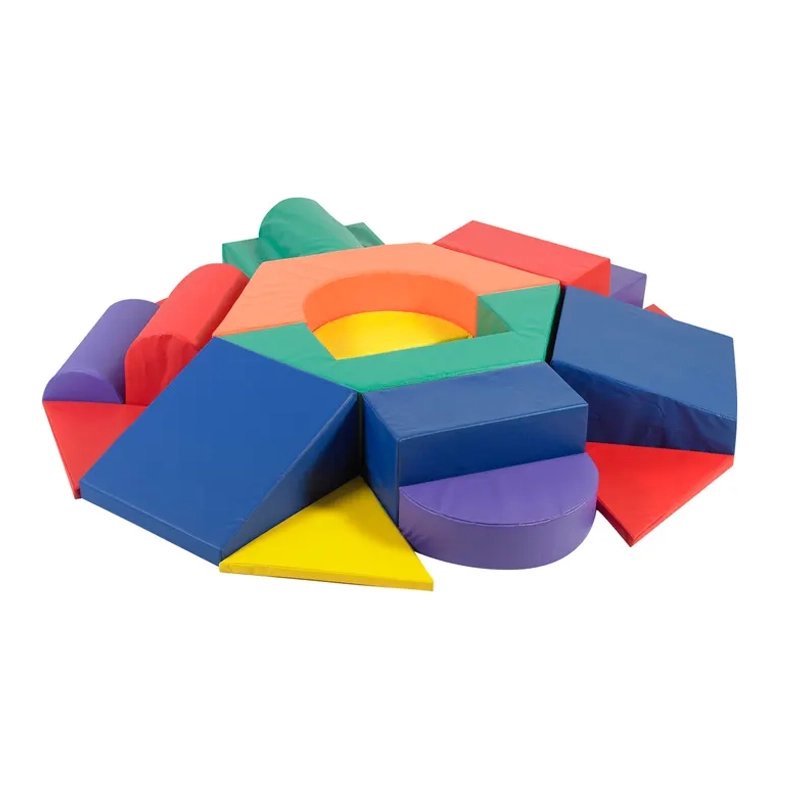
متسلق الصواميل والمسامير للأطفال

مكعبات لعب ناعمة مكونة من 6 قطع
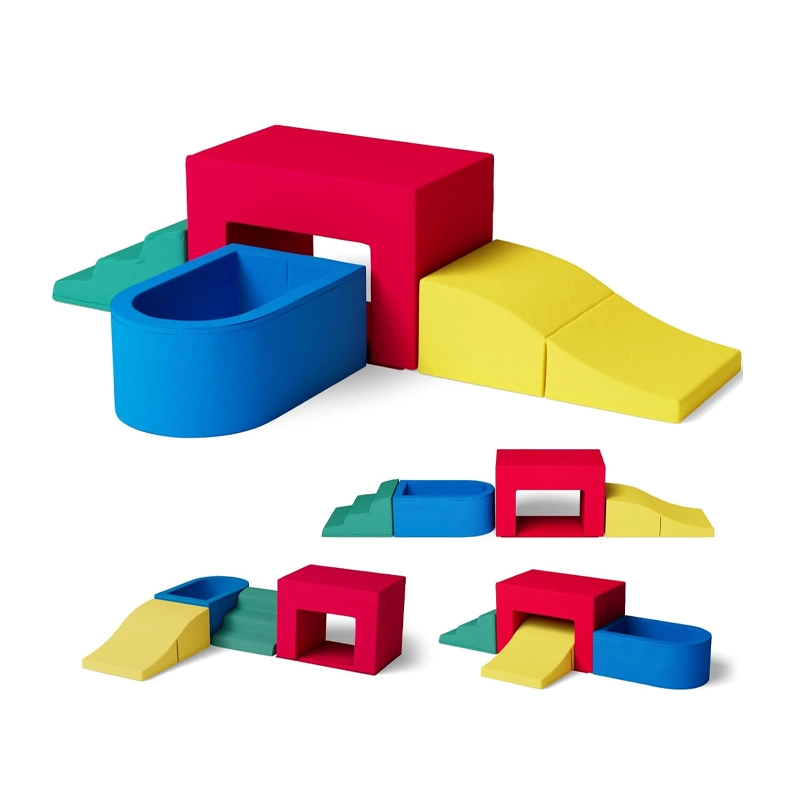
مجموعة تسلق ناعمة مكونة من 4 قطع

مكعبات تسلق من الإسفنج للأطفال
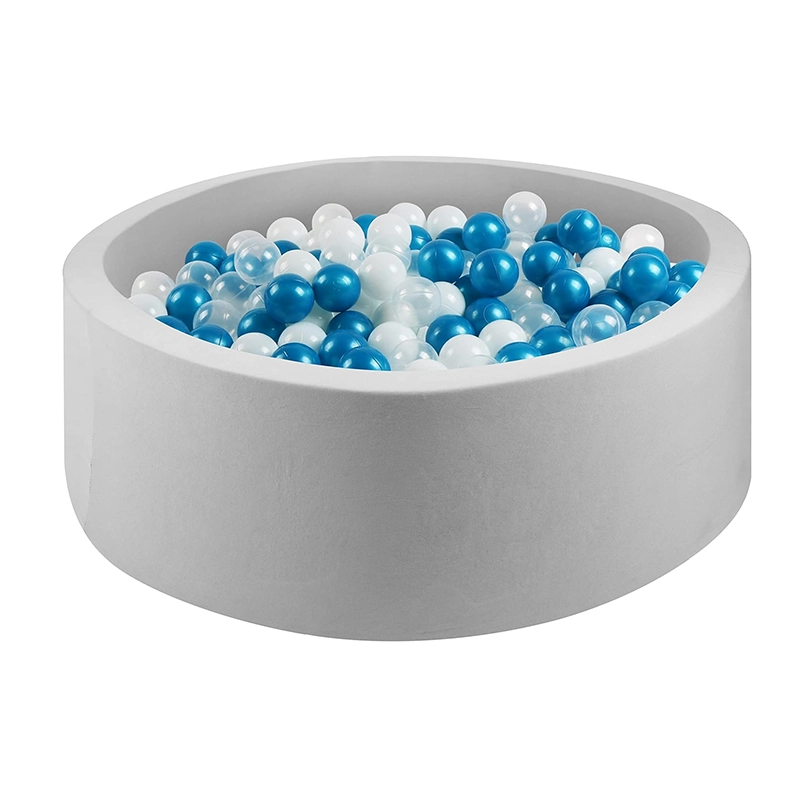
حفرة الكرات الرغوية الناعمة

نفق الشجرة والمتسلق

معدات اللعب الناعمة من الفوم قوس قزح
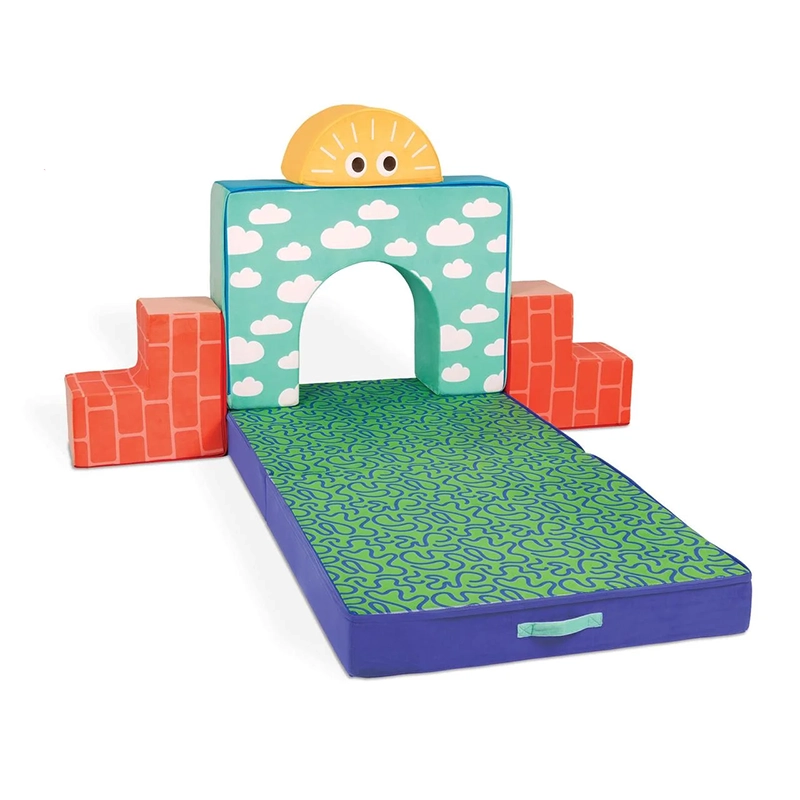
مجموعة بناء قلعة السحاب
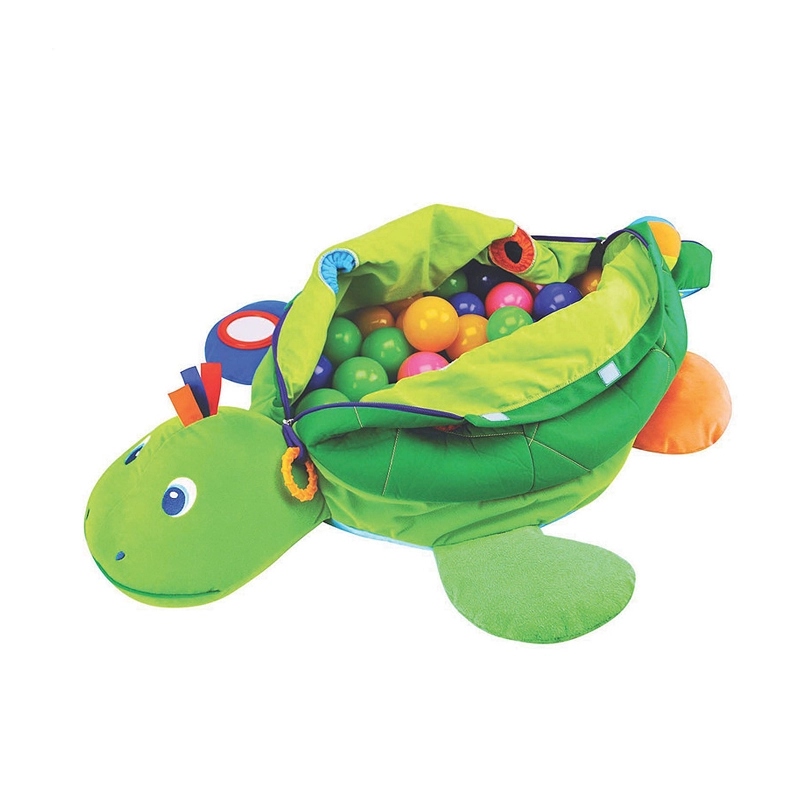
حفرة كرات السلحفاة
الشركة المصنعة والموردة لأثاث ما قبل المدرسة المخصص
بخبرة تزيد عن 20 عامًا في صناعة أثاث ما قبل المدرسة، تُعدّ وينينج كيدز اسمًا موثوقًا به في ابتكار حلول لعب مبتكرة وعالية الجودة لتنمية الطفولة المبكرة. التزامنا بالحرفية والسلامة يضمن تصميم كل منتج لتعزيز بيئات التعلم، مع توفير مساحة آمنة وجذابة للأطفال للنمو واللعب.
منتجات ألعابنا اللينة مصنوعة من مواد متينة ومناسبة للأطفال، ومصممة لتتحمل متطلبات مناطق اللعب المزدحمة. من سجادات اللعب ذات الألوان الزاهية إلى هياكل التسلق المبتكرة، تُعزز معداتنا اللينة النشاط البدني والتنسيق الحركي والتفاعل الاجتماعي. مع وينينج كيدز، كن على ثقة بأن كل قطعة مصممة لتوفير متعة دائمة وفوائد تنموية في بيئة آمنة ومأمونة.
من استخدام مواد صديقة للبيئة إلى تحسين أساليب الإنتاج، نسعى جاهدين لتقليل بصمتنا البيئية. من خلال دمج الاستدامة في كل جانب من جوانب عمليتنا، نهدف إلى إنشاء منتجات لا تدعم نمو وتطور الأطفال فحسب، بل تساهم أيضًا بشكل إيجابي في مستقبل الكوكب.

ما هو اللعب الناعم؟
يُقصد باللعب الناعم بيئة لعب آمنة وممتعة للأطفال الصغار، حيث يمكنهم المشاركة في أنشطة متنوعة باستخدام معدات ناعمة ومبطنة. صُممت هذه المناطق لتشجيع النشاط البدني والإبداع والتفاعل الاجتماعي في بيئة مُحكمة. تشمل معدات اللعب الناعم سجادات اللعب الناعمة، وأحواض الكرات، ومكعبات التسلق، وأجهزة تضمن سلامة الأطفال أثناء استكشافهم وتعلمهم وقضاء وقت ممتع. يُعد اللعب الناعم أساسيًا في نمو الطفولة المبكرة، إذ يُساعد الأطفال على تحسين مهاراتهم الحركية، وتنسيقهم الحركي، وقدرتهم على حل المشكلات.
فوائد اللعب الناعم
توفر مناطق اللعب الناعمة ومعداتها العديد من المزايا، مما يجعلها إضافة أساسية لمدارس ما قبل المدرسة ودور الحضانة، وحتى المنازل. من أهم هذه المزايا:
يعزز التطور البدني
يشجع اللعب الخفيف الأطفال على ممارسة أنشطة بدنية كالتسلق والقفز والزحف والتوازن. تساعد هذه الحركات على تطوير المهارات الحركية والتنسيق والقوة، مع تحسين اللياقة البدنية بشكل عام.
يعزز المهارات الاجتماعية
غالبًا ما تشجع مناطق اللعب الناعمة اللعب الجماعي، مما يعزز العمل الجماعي والتواصل والمشاركة. يتعلم الأطفال كيفية التفاعل مع الآخرين، وحل النزاعات، والعمل معًا في بيئة اجتماعية.
يعزز التطور المعرفي
تُحفّز العديد من ألعاب الأطفال الناعمة، مثل المكعبات والأنفاق ومسارات العوائق، الأطفال على التفكير الإبداعي وحل المشكلات. تُحفّز هذه الأنشطة التفكير النقدي والوعي المكاني والقدرة على حل المشكلات.
يوفر تحفيزًا حسيًا
توفر معدات اللعب الناعمة مجموعة متنوعة من القوام والألوان والأشكال، مما يُحفز الحواس. هذا يُساعد الأطفال على تطوير مهارات المعالجة الحسية وإثارة فضولهم من خلال اللمس والبصر والحركة.
يشجع الاستكشاف الآمن
صُممت بيئات اللعب الناعمة مع مراعاة السلامة. تمتص الأسطح المبطنة الصدمات، مما يقلل من خطر الإصابة، ويتيح للأطفال الاستكشاف والمخاطرة في بيئة آمنة وخاضعة للرقابة.
يحسن التطور العاطفي
يمكن أن يساعد اللعب الخفيف الأطفال على بناء ثقتهم بأنفسهم أثناء خوض تحديات كالتسلق أو الزحف عبر الأنفاق. إن إنجاز المهام بنجاح يعزز ثقتهم بأنفسهم وقدرتهم على التكيف العاطفي، مما يشجعهم على تجربة أشياء جديدة.
مواد معدات اللعب الناعمة
تُصنع معدات اللعب الناعمة من مواد متنوعة مصممة لتكون آمنة ومتينة ومريحة للأطفال الصغار. تُختار هذه المواد بعناية لتوفير الحماية الجسدية وتشجيع التفاعل الحسي أثناء اللعب. فيما يلي أكثر المواد شيوعًا في معدات اللعب الناعمة:
1. المطاط
- وصفيُستخدم المطاط عادةً لخصائصه في امتصاص الصدمات. فهو مادة أكثر صلابةً من الإسفنج، ولكنه ناعمٌ بما يكفي لتوفير بعض التوسيد.
- يستخدم:تستخدم الحصائر والأرضيات المطاطية بشكل شائع في مناطق اللعب الناعمة ذات الحركة المرورية الكثيفة، مثل تلك الموجودة أسفل الهياكل المتسلقة أو كأرضيات في مناطق اللعب.
- فوائد:متانة ممتازة، ومقاومة للماء، ومقاومة للانزلاق، وسهلة التنظيف للغاية.
2. PVC (بولي فينيل كلوريد)
- وصف:PVC عبارة عن مادة بلاستيكية صلبة ومتينة ومرنة تغطي الهياكل الرغوية أو القابلة للنفخ.
- يستخدميُستخدم البولي فينيل كلوريد (PVC) عادةً في التغطية الخارجية لألعاب النفخ، مثل بيوت القفز، وأحواض الكرات، والأنفاق. كما يُمكن استخدامه في صنع حصائر اللعب الناعمة أو المنزلقات المغطاة بالإسفنج.
- فوائد:إنه مقاوم للماء، وسهل التنظيف، ومقاوم للتآكل، ومتوفر بمجموعة واسعة من الألوان والقوام.
3.فينيل
- وصفالفينيل مادة صناعية معروفة بمتانتها ومرونتها. يشبه كلوريد البوليفينيل (PVC) ولكنه أكثر نعومةً قليلاً.
- يستخدم:غالبًا ما يتم استخدامه في صنع الأسطح المبطنة والقابلة للنفخ مثل حفر الكرات والمنزلقات وأنفاق اللعب الناعمة.
- فوائدناعم، متين، وسهل الصيانة. كما أن الفينيل مقاوم للبقع، ويتحمل الاستخدام المتكرر دون أن يتلف.
4. رغوة البولي يوريثان (PU)
- وصفرغوة البولي يوريثان خيار شائع آخر لمعدات اللعب الناعمة. فهي أكثر كثافة وصلابة من الرغوة العادية، لكنها توفر سطحًا آمنًا للعب.
- يستخدم:تستخدم رغوة البولي يوريثان بشكل شائع في الهياكل مثل إطارات التسلق والحواجز المبطنة ومسارات العوائق.
- فوائد:متينة، طويلة الأمد، وتوفر دعمًا أكبر للهياكل الأكبر حجمًا والأثقل وزنًا. كما تتميز رغوة البولي يوريثان بمقاومتها للهب وقدرتها على تحمل الصدمات الشديدة.
5. Nylon & Polyester Fabrics
- وصفتُستخدم هذه المواد غالبًا كأغطية لمنتجات اللعب الناعمة. وهي أقمشة منسوجة متينة ومرنة.
- يستخدميُستخدم النايلون والبوليستر عادةً في الطبقة الخارجية لمكعبات الرغوة، أو الحصائر، أو أدوات اللعب القابلة للنفخ. وغالبًا ما تُطلى هذه الأقمشة لجعلها مقاومة للماء وسهلة التنظيف.
- فوائدخفيفة الوزن، سهلة التنظيف، ومتوفرة بألوان وأقمشة متنوعة تجعل مناطق اللعب جذابة بصريًا. كما أنها مقاومة للتمزق والتآكل.
6. الرغوة
- وصف:الرغوة من أكثر المواد استخدامًا في معدات اللعب الناعمة. فهي خفيفة الوزن، ومُبطّنة، وتمتص الصدمات لمنع الإصابات.
- يستخدم:تُستخدم الرغوة عادةً في الحصائر المبطنة، ومكعبات التسلق، وأشكال اللعب المختلفة (مثل المكعبات، والأوتاد، والمنحدرات). تتميز بمرونتها وسهولة تقطيعها إلى أشكال متنوعة، مما يجعلها متعددة الاستخدامات لإنشاء مناطق لعب ناعمة.
- فوائد:ناعم، يمتص الصدمات، آمن للأطفال، ويمكن تغطيته بقماش متين لسهولة التنظيف.
أنواع معدات اللعب الناعمة
تتوفر معدات اللعب الناعمة بأنواع مختلفة، مصممة لتناسب مختلف الفئات العمرية وبيئات اللعب. من بين الأنواع الشائعة:

دورات العوائق

سجادات اللعب الناعمة

الأنفاق

بيوت القفز

حفر الكرات
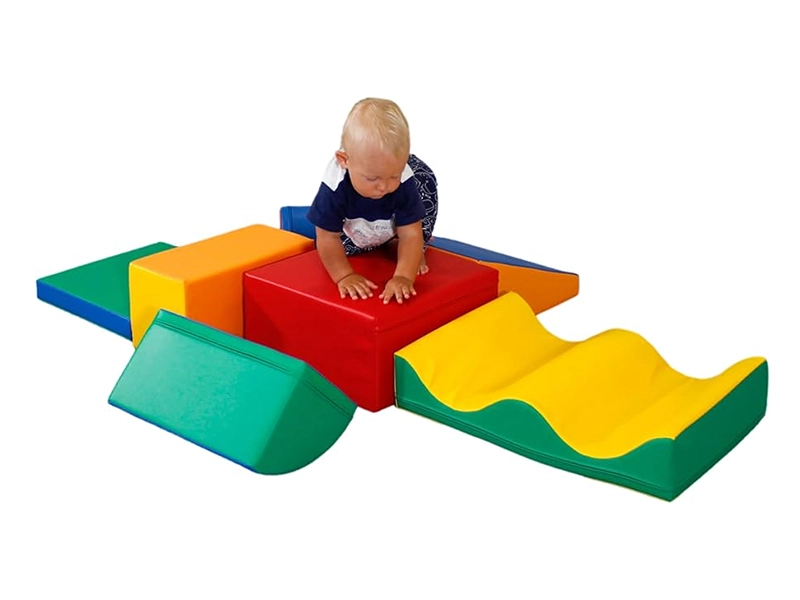
طاولات الأنشطة

مكعبات اللعب الناعمة

هياكل التسلق
كيفية اختيار معدات اللعب الناعمة المناسبة؟
عند اختيار معدات اللعب الناعمة، من الضروري مراعاة عدة عوامل لضمان الملاءمة المناسبة لمساحتك والأطفال الذين يستخدمونها.
الفئة العمرية والاحتياجات التنموية:الخطوة الأولى لاختيار معدات اللعب الناعمة هي فهم الفئة العمرية للأطفال الذين سيستخدمونها. تتطلب الفئات العمرية المختلفة تصاميم وميزات مختلفة لتلبية احتياجات نموها.
السلامة والمتانة:السلامة هي الشغل الشاغل عند اختيار معدات اللعب الناعمة. تأكد دائمًا من أن المعدات التي تختارها تتوافق مع معايير ولوائح السلامة الدولية.
المساحة والتخطيط:قبل اختيار أي معدات ألعاب ناعمة، قِس المساحة المتوفرة لديك بعناية. يجب ألا تقتصر مساحة اللعب الناعمة على حجمها فحسب، بل يجب أن تسمح أيضًا بسهولة الحركة والوصول.
الموضوع والجاذبية الجمالية: يُعدّ مظهر وملمس معدات اللعب الناعمة أمرًا بالغ الأهمية لجذب الأطفال للمشاركة في اللعب. فالألوان الزاهية والأشكال الجذابة والتصاميم ذات الطابع الخاص تُحسّن الجو العام لمنطقة اللعب.
الميزانية وكفاءة التكلفة: عند اختيار معدات اللعب الناعمة، ينبغي مراعاة قيود الميزانية. فمع أهمية الاستثمار في منتجات عالية الجودة، من الضروري أيضًا إيجاد حل يناسب ميزانيتك.
- التخصيص ومرونة التصميم: لكل مؤسسة تعليمية احتياجاتها الخاصة ومساحتها المحدودة. لذا، يُعد اختيار مورد يوفر معدات لعب ناعمة قابلة للتخصيص ميزة كبيرة.
مركز اللعب الناعم مقابل الملعب التقليدي
| ميزة | مرآة مونتيسوري | مرآة تقليدية |
|---|---|---|
| أمان | أسطح مبطنة، ومواد تمتص الصدمات، ولعب تحت الإشراف. | الأسطح الصلبة، خطر الإصابة أعلى، إشراف أقل. |
| الاعتماد على الطقس | معظمها مرافق داخلية، مما يجعلها مناسبة لجميع الظروف الجوية. | إعداد خارجي، يعتمد على الطقس. |
| الفئة العمرية | مناسب للأطفال الصغار (من سن الأطفال الصغار إلى سن ما قبل المدرسة). | مناسب لمجموعة عمرية أوسع، من الأطفال الصغار إلى الأطفال الأكبر سنًا. |
| النشاط البدني | يشجع الزحف والتسلق واللعب البدني اللطيف. | يشجع على اللعب الأكثر نشاطًا مثل الجري والتأرجح والتسلق. |
| صيانة | سهلة الصيانة بفضل المواد والأسطح القابلة للغسل. | تتطلب صيانة أكثر تكرارًا بسبب التعرض للطقس. |
| كفاءة المساحة | مدمجة وقابلة للتكيف مع المساحات الداخلية الأصغر حجمًا. | تتطلب مساحة خارجية أكبر، وغالبًا ما تكون كبيرة الحجم. |
| الإشراف | من الأسهل مراقبة الأطفال في بيئة خاضعة للرقابة. | من الصعب مراقبتها في الأماكن الخارجية المفتوحة. |
| الفوائد التنموية | التركيز على المهارات الحركية والتنسيق واللعب الحسي والاستكشاف الآمن. | التركيز على القوة البدنية والتوازن والاستكشاف في الهواء الطلق. |
| يكلف | تكلفة إعداد أولية أعلى للمعدات الداخلية والصيانة. | تكلفة إعداد أقل ولكنها قد تتطلب استثمارًا مستمرًا للصيانة. |
مركز اللعب الناعم مقابل الملعب التقليدي
عند تجهيز مناطق اللعب الناعمة، يُعدّ عمر الأطفال الذين يستخدمونها من أهم العوامل التي يجب مراعاتها. يجب أن تُصمّم معدات اللعب الناعمة بما يتناسب مع مراحل النمو والقدرات البدنية لمختلف الفئات العمرية، لضمان سلامة كل طفل وتفاعله.

ألعاب ناعمة للأطفال الرضع (0-2 سنة)
ينبغي أن تُركز مناطق اللعب الناعمة على تنمية المهارات الحسية والحركية الأساسية للرضع. في هذه المرحلة، يبدأ الأطفال باستكشاف محيطهم والتحكم في حركات أجسامهم. يجب أن تكون معدات اللعب الناعمة بسيطة وآمنة وسهلة التفاعل معهم.
المعدات الموصى بها:
- سجادات ووسائد ناعمة:توفر الحصائر الناعمة مساحة آمنة للأطفال للزحف والتدحرج والاستكشاف. يمكن ترتيب هذه الحصائر بأشكال متنوعة لتحفيز وتشجيع الحركة.
- وسادات وقت النوم على البطن:تم تصميم هذه اللعبة لمساعدة الأطفال على التدرب على رفع رؤوسهم، مما يساعد على تقوية عضلات الرقبة والكتف.
- أنفاق الزحف:تعمل الأنفاق الخفيفة والناعمة على تشجيع الزحف وتعزيز النشاط البدني، وتطوير التنسيق والقوة لدى الأطفال.
- اللعب الحسي:يمكن للوسائد المزخرفة أو مكعبات اللعب الناعمة ذات الألوان والأنماط المختلفة تحفيز التطور البصري واللمسي.

ألعاب ناعمة للأطفال الصغار (2-4 سنوات)
مع تطور مهارات التنسيق والتوازن وخفة الحركة لدى الأطفال الصغار، ينبغي أن تتضمن مناطق اللعب الناعمة معدات تُشجع على التسلق والقفز وحل المشكلات الأساسية. في هذه المرحلة، يصبح الأطفال الصغار أكثر اجتماعية ويستمتعون باللعب التفاعلي، مما يُسهم في نموهم المعرفي والاجتماعي.
المعدات الموصى بها:
- هياكل التسلق:يمكن أن تساعد الهياكل الناعمة والمنخفضة للتسلق مثل المنحدرات أو التلال الصغيرة الأطفال الصغار على تطوير القوة والتنسيق مع توفير الشعور بالإنجاز.
- الشرائح الصغيرة:توفر الشرائح المصنوعة من مواد ناعمة ومبطنة طريقة ممتعة للأطفال الصغار لممارسة التوازن والتنسيق مع ضمان سلامتهم.
- لوحات اللعب التفاعلية:يمكن للألواح التي تحتوي على أزرار وملمس وألوان أن تجذب الأطفال الصغار وتشجعهم على التعلم الحسي والاستكشاف.
- مناطق الزحف والقفز:المناطق التي يمكن للأطفال الصغار القفز أو التدحرج فيها تعتبر رائعة لتطوير المهارات الحركية والوعي المكاني.

ألعاب ناعمة لمرحلة ما قبل المدرسة (4-6 سنوات)
يتطور لدى أطفال ما قبل المدرسة بسرعة مهاراتهم الحركية، وقدراتهم الاجتماعية، ووظائفهم الإدراكية. ومع ازدياد ثقتهم بأنفسهم، يمكن أن تتضمن معدات اللعب الناعمة هياكل أكثر تعقيدًا تُحفزهم جسديًا وعقليًا. في هذه المرحلة، يكون الأطفال أكثر ميلًا للانخراط في اللعب التخيلي، لذا من المهم دمج التصاميم المفتوحة.
المعدات الموصى بها:
- دورات العوائق:تحديات دورات العقبات البسيطة التي تحتوي على منحدرات وأنفاق وحواجز ناعمة تشجع الأطفال في سن ما قبل المدرسة على التفكير بشكل استراتيجي مع تطوير المرونة والقوة والوعي المكاني.
- جدران التسلق:يمكن أن تساعد جدران التسلق المنخفضة المبطنة أو ميزات التسلق الناعمة الأطفال في سن ما قبل المدرسة على العمل على قوة الجزء العلوي من الجسم وتنسيقه.
- مناطق اللعب متعددة المستويات:تتيح هياكل اللعب ذات المستويات المتعددة للأطفال في سن ما قبل المدرسة استكشاف ارتفاعات ومساحات مختلفة، مما يحسن التنسيق ويشجع اللعب الخيالي.
- بيوت اللعب التفاعلية:يمكن أن يشمل ذلك بيوت اللعب الناعمة ذات الأنفاق المدمجة والمنزلقات ومناطق التسلق، مما يوفر فرصًا لا حصر لها للعب التظاهري.
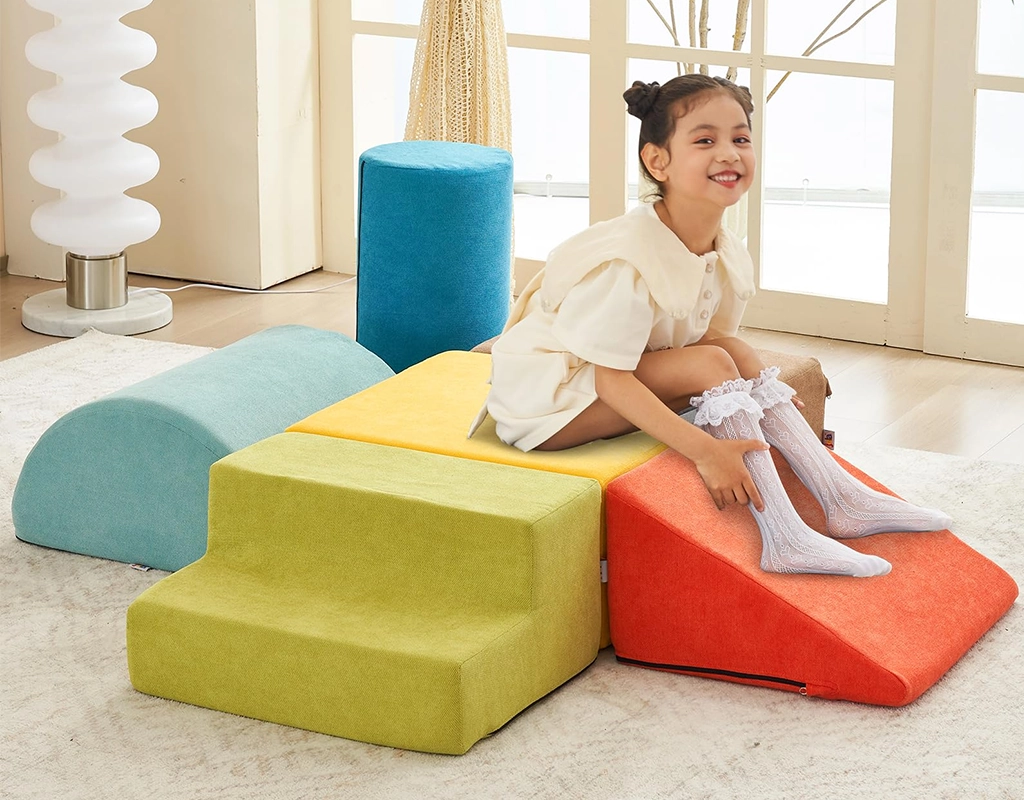
منطقة لعب ناعمة للأطفال الأكبر سنًا (6 سنوات فأكثر)
مع تقدم الأطفال في السن، تزداد قدراتهم البدنية وحاجتهم إلى أنشطة لعب أكثر تحديًا. بالنسبة للأطفال فوق سن السادسة، توفر مناطق اللعب الناعمة معدات أكثر تطورًا تُنمي قدراتهم البدنية والإدراكية. كما تبدأ هذه المجموعة بالانخراط في لعب جماعي أكثر تنظيمًا، مما يُساعد على النمو الاجتماعي.
المعدات الموصى بها:
- هياكل التسلق المتقدمة:توفر جدران التسلق الطويلة والسُلالم والشبكات تحديًا أكبر وتعزز القدرة على التحمل والقوة وحل المشكلات.
- عوارض التوازن:يمكن أن تساعد عوارض التوازن المنخفضة في تحسين الاستقرار والتنسيق مع تشجيع الأطفال على دفع أنفسهم جسديًا.
- مناطق اللعب متعددة الاستخدامات:تتيح هذه المناطق للأطفال المشاركة في أنشطة مختلفة، مثل الجري أو القفز أو الزحف، مما يعزز خفة الحركة والمرونة والإبداع.
- مناطق اللعب الجماعية:يمكن لمساحات اللعب الناعمة الكبيرة التي تحتوي على عناصر تفاعلية مثل الأراجيح أو الأقراص الدوارة أو مناطق التسلق الجماعية أن تعزز اللعب التعاوني والمهارات الاجتماعية.
إرشادات لإنشاء مركز ألعاب ناعمة
يتطلب إنشاء مركز ألعاب ناعمة تخطيطًا مدروسًا لضمان أن يكون المكان آمنًا وجذابًا وفعالًا. إليك بعض الإرشادات الأساسية التي يجب مراعاتها عند إنشاء مركز الألعاب الناعمة:
تخطيط وتخطيط المساحات:
- زيادة المساحةتأكد من أن المساحة واسعة بما يكفي لاستيعاب أنواع مختلفة من معدات اللعب الناعمة، مثل حُفر الكرات، ومكعبات التسلق، والأنفاق، والحصائر. صمم تصميمًا يسمح بسهولة الحركة والإشراف.
- تقسيم المناطقخصص مناطق مختلفة للأنشطة المتنوعة (مثل منطقة التسلق، ومنطقة الزحف، ومنطقة حفرة الكرات). سيساعد هذا على تنظيم المساحة وتوفير تجارب لعب متنوعة للأطفال.
ميزات السلامة والمواد:
- الأرضيات الناعمةركّب سجادات لعب ناعمة أو أرضيات مبطنة في جميع أنحاء المركز لتقليل خطر الإصابة. تأكد من أن الأرضية مانعة للانزلاق، وممتصة للصدمات، وسهلة التنظيف.
- معدات آمنةاختر معدات مصنوعة من مواد متينة وغير سامة، مثل الإسفنج والفينيل والمطاط. تأكد من أن حواف جميع المعدات مستديرة لتجنب الزوايا الحادة.
- الحواجز والبواباتاستخدم بوابات أو أسوارًا ناعمة لتحديد منطقة اللعب وحماية الأطفال من التجول. تأكد من سهولة الوصول إليها للأطفال والبالغين المشرفين.
الإشراف المناسب والتوظيف:
- التوظيف: توظيف موظفين مدربين للإشراف على الأطفال والحفاظ على بيئة لعب آمنة. تأكد من إلمام الموظفين بسلامة الأطفال والإسعافات الأولية.
- الرؤيةتأكد من أن الموظفين يستطيعون رؤية جميع أجزاء مركز الألعاب اللينة بسهولة، حتى من مسافة بعيدة. يمكنك تحقيق ذلك بوضع مساحات مفتوحة أو حواجز شفافة بشكل استراتيجي.
إمكانية الوصول:
- تأكد من أن المركز مُتاح لجميع الأطفال، بمن فيهم ذوو الإعاقة. فكّر في إضافة منحدرات، وأبواب أوسع، ومعدات لعب حسية لاستيعاب الأطفال ذوي الاحتياجات الخاصة.
اختر المعدات المناسبة لعمرك:
- ضع في اعتبارك الفئة العمرية للأطفال الذين سيستخدمون المساحة. سجادات اللعب الناعمة، ومكعبات التسلق للأطفال الصغار، وألعاب الإسفنج مثالية للأطفال الصغار. أما للأطفال الأكبر سنًا، فيمكنك إضافة عناصر أكثر تحديًا مثل الزحاليق والأنفاق وهياكل التسلق الأكبر حجمًا.
- الفصل حسب العمر:لضمان السلامة، ضع في اعتبارك تخصيص مناطق لعب منفصلة لمجموعات عمرية مختلفة، مثل منطقة لعب ناعمة للأطفال الصغار ومنطقة لعب ناعمة للأطفال.
النظافة والصيانة:
- مواد سهلة التنظيف:اختر المعدات المصنوعة من مواد مثل الفينيل والمطاط، والتي يسهل مسحها وتطهيرها.
- التنظيف الروتيني:طبّق جدول تنظيف يومي لضمان نظافة منطقة اللعب. يشمل ذلك تنظيف المعدات والأرضيات والألعاب بانتظام.
- عمليات التفتيش الدورية:إجراء فحوصات روتينية للتأكد من أن كل شيء يظل في حالة عمل آمنة.
تصميم تفاعلي وجذاب:
- ميزات ممتعة:أضف عناصر مثل الألعاب الناعمة الملونة أو الجدران التفاعلية أو مناطق اللعب ذات الطابع الخاص لجعل المركز أكثر جاذبية للأطفال.
- اللعب الخياليأدرج عناصر تُشجّع على اللعب الإبداعي، مثل مطابخ اللعب اللينة، والمكعبات اللينة، ومجموعات الألعاب. تُساعد هذه العناصر الأطفال على إطلاق العنان لإبداعهم أثناء اللعب.
منطقة انتظار مريحة للآباء:
- جهّزوا منطقة انتظار مريحة لأولياء الأمور والأوصياء، مزودة بمقاعد ومرطبات ورؤية واضحة لمنطقة اللعب. هذا يضمن راحة أولياء الأمور مع مراقبة أطفالهم.
احتياطات السلامة لمناطق اللعب الناعمة
ضمان سلامة الأطفال في مناطق اللعب الناعمة أمر بالغ الأهمية. فيما يلي احتياطات السلامة الرئيسية التي يجب مراعاتها عند إنشاء منطقة لعب ناعمة وصيانتها:
-
عمليات التفتيش الدورية يجب فحص معدات اللعب الناعمة بانتظام للتأكد من عدم وجود أي تلف أو تلف في مكوناتها، مثل الأجزاء المفكوكة أو الحواف الحادة أو المواد التالفة. يضمن الفحص اليومي للمعدات تحديد أي مخاطر محتملة ومعالجتها على الفور.
-
لافتات السلامة الواضحة وفّر لافتات واضحة تُذكّر الآباء والأطفال بقواعد السلامة وإرشاداتها، مثل منع اللعب العنيف، ومنع القفز من المرتفعات، والالتزام بالسلوكيات المناسبة داخل منطقة اللعب. هذا يضمن وعي الجميع بمتطلبات اللعب الآمن.
-
حدود الوزن والسعة يجب أن تكون لمعدات اللعب الناعمة حدود وزن وسعة محددة لتجنب التحميل الزائد على هيكلها. الالتزام بهذه الحدود يضمن ثبات المعدات وسلامتها للاستخدام.
-
مراقبة سلوك الأطفال شجّع الأطفال على اللعب بأمان وتجنب السلوكيات العنيفة أو الخطرة، مثل التسلق على معدات غير مخصصة للتسلق، أو الدفع، أو الشد. يجب التركيز على اللعب اللطيف والمحترم.
-
طرق الخروج وإجراءات الطوارئ تأكد من وجود مخارج محددة وإجراءات طوارئ. في حالة الطوارئ، يجب على الموظفين والزوار معرفة أماكن المخارج وكيفية الإخلاء الآمن.
-
النظافة والصحة يُعدّ التنظيف والتعقيم المنتظم لمعدات الألعاب الناعمة أمرًا ضروريًا لمنع انتشار الجراثيم والبكتيريا. يجب مسح الأسطح باستمرار، خاصةً في المناطق التي تلامس بعضها البعض بكثرة، مثل مكعبات الإسفنج والحصائر والأنفاق.
التعليمات
ما هو اللعب الناعم؟
تشير كلمة اللعب الناعم إلى بيئة لعب آمنة ومبطنة مصممة للأطفال الصغار لاستكشاف الأشياء والتسلق والزحف وتطوير المهارات الحركية. وهي تشمل هياكل رغوية وأنفاقًا ومنزلقات وحصائر وعناصر تفاعلية، وكلها مصنوعة من مواد ناعمة تمتص الصدمات.
لماذا اللعب الناعم مفيد للأطفال؟
تشجع الألعاب الناعمة التطور البدني والاستكشاف الحسي والتوازن والتنسيق والتفاعل الاجتماعي في بيئة آمنة وخاضعة للرقابة. كما أنها تعزز حل المشكلات وبناء الثقة واللعب الإبداعي.
هل يمكن استخدام الألعاب الناعمة في الهواء الطلق؟
نعم، تم تصميم بعض معدات اللعب الناعمة للاستخدام في الهواء الطلق، وهي مصنوعة من مواد مقاومة للأشعة فوق البنفسجية ومقاومة للماء ومتينة. تحقق دائمًا من مواصفات المنتج للتأكد من ملاءمته للبيئات الخارجية.
كيف أقوم بتنظيف وصيانة معدات اللعب الناعمة؟
امسح الأسطح بمطهر خفيف آمن على الأطفال يوميًا، واغسل الأغطية القماشية القابلة للإزالة بانتظام. بالنسبة للمنشآت التجارية، يجب إجراء التنظيف العميق أسبوعيًا أو حسب الحاجة.
هل اللعب الناعم مناسب للأطفال ذوي الاحتياجات الخاصة؟
نعم، غالبًا ما يتم استخدام اللعب الناعم في العلاج الحسي للأطفال المصابين بالتوحد أو غيره من حالات النمو، لأنه يوفر بيئة آمنة وحسية وجذابة للاستكشاف والحركة.
كيف يمكنني إنشاء منطقة لعب ناعمة في المنزل؟
لتجهيز منطقة لعب ناعمة في المنزل، ابدأ بتقييم المساحة المتاحة واختيار الأرضيات المبطنة أو الحصائر الرغوية المناسبة لضمان السلامة. ثم اختر معدات اللعب الناعمة المناسبة للعمر، مثل الأنفاق الزاحفة والمنزلقات والكتل الرغوية، لتعزيز النشاط البدني والتنسيق. لتعزيز تجربة اللعب، قم بدمج الألعاب الملونة والحسية، وتأكد من الحفاظ على نظافة المنطقة وصيانتها جيدًا. أخيرًا، تحقق بانتظام من سلامة المعدات للتأكد من أن طفلك يمكنه الاستمتاع مع الحفاظ على سلامته.
ما هي الفئة العمرية المناسبة للعب الناعم؟
عادةً ما يتم تصميم أماكن اللعب الناعمة للأطفال الذين تتراوح أعمارهم بين 6 أشهر إلى 6 سنوات، على الرغم من أن بعض الهياكل الأكبر حجمًا تناسب الأطفال الأكبر سنًا. تحقق دائمًا من النطاق العمري الموصى به لمناطق اللعب أو المعدات المحددة.
هل يمكن تخصيص اللعب الناعم؟
نعم، يمكن بالتأكيد تخصيص مناطق اللعب الناعمة لتناسب احتياجاتك وتفضيلاتك المحددة. يقدم العديد من الموردين معدات لعب ناعمة قابلة للتخصيص، مما يسمح لك باختيار الحجم واللون والتصميم ونوع المعدات التي تناسب مساحتك وعمر الأطفال الذين سيستخدمونها. يمكنك الاختيار من بين عناصر مختلفة مثل كتل الرغوة والأنفاق والمنزلقات وهياكل التسلق، وحتى دمج ميزات تعليمية مثل الأشكال أو الأرقام أو القوام. يضمن التخصيص أن منطقة اللعب الناعمة لا تلبي معايير السلامة فحسب، بل تكمل أيضًا المتطلبات الجمالية والوظيفية لمنزلك أو منشأتك.

